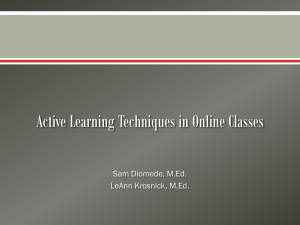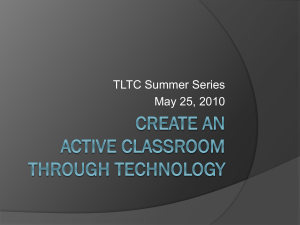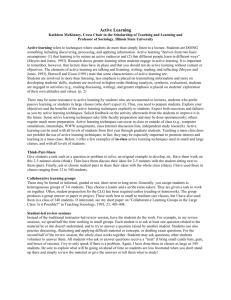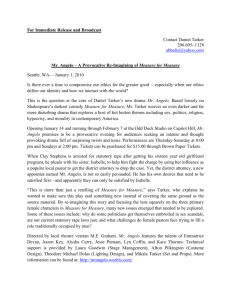Teaching and Learning Strategies
advertisement
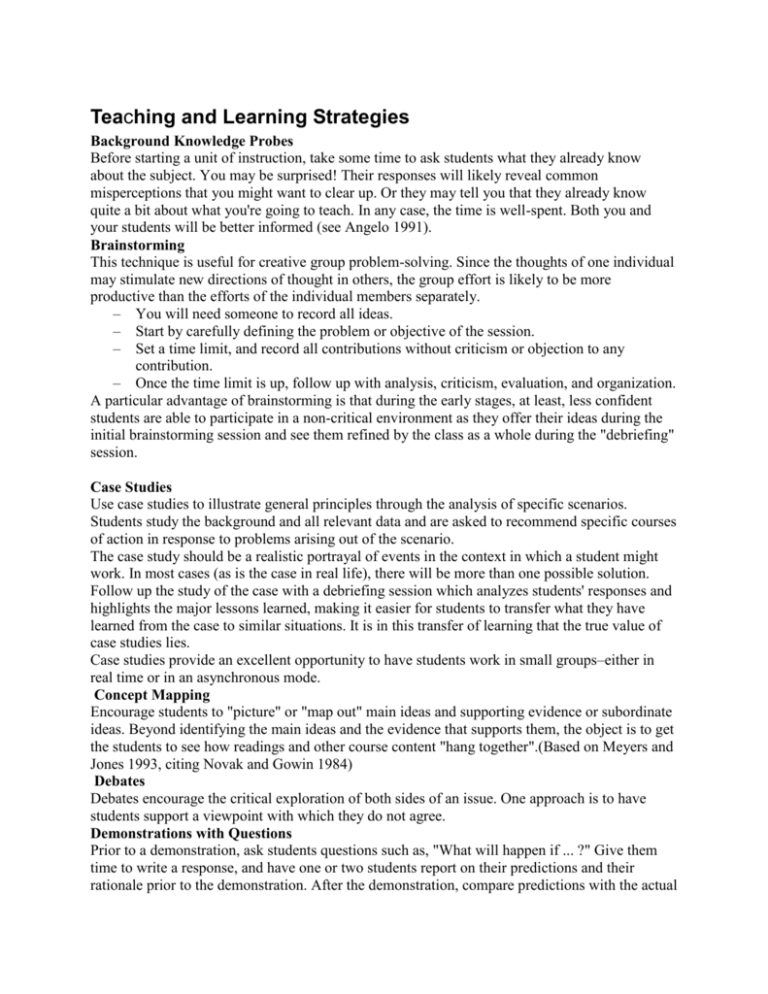
Teaching and Learning Strategies Background Knowledge Probes Before starting a unit of instruction, take some time to ask students what they already know about the subject. You may be surprised! Their responses will likely reveal common misperceptions that you might want to clear up. Or they may tell you that they already know quite a bit about what you're going to teach. In any case, the time is well-spent. Both you and your students will be better informed (see Angelo 1991). Brainstorming This technique is useful for creative group problem-solving. Since the thoughts of one individual may stimulate new directions of thought in others, the group effort is likely to be more productive than the efforts of the individual members separately. – You will need someone to record all ideas. – Start by carefully defining the problem or objective of the session. – Set a time limit, and record all contributions without criticism or objection to any contribution. – Once the time limit is up, follow up with analysis, criticism, evaluation, and organization. A particular advantage of brainstorming is that during the early stages, at least, less confident students are able to participate in a non-critical environment as they offer their ideas during the initial brainstorming session and see them refined by the class as a whole during the "debriefing" session. Case Studies Use case studies to illustrate general principles through the analysis of specific scenarios. Students study the background and all relevant data and are asked to recommend specific courses of action in response to problems arising out of the scenario. The case study should be a realistic portrayal of events in the context in which a student might work. In most cases (as is the case in real life), there will be more than one possible solution. Follow up the study of the case with a debriefing session which analyzes students' responses and highlights the major lessons learned, making it easier for students to transfer what they have learned from the case to similar situations. It is in this transfer of learning that the true value of case studies lies. Case studies provide an excellent opportunity to have students work in small groups–either in real time or in an asynchronous mode. Concept Mapping Encourage students to "picture" or "map out" main ideas and supporting evidence or subordinate ideas. Beyond identifying the main ideas and the evidence that supports them, the object is to get the students to see how readings and other course content "hang together".(Based on Meyers and Jones 1993, citing Novak and Gowin 1984) Debates Debates encourage the critical exploration of both sides of an issue. One approach is to have students support a viewpoint with which they do not agree. Demonstrations with Questions Prior to a demonstration, ask students questions such as, "What will happen if ... ?" Give them time to write a response, and have one or two students report on their predictions and their rationale prior to the demonstration. After the demonstration, compare predictions with the actual outcomes and ask students to suggest reasons for any discrepancies. (Based on Bonwell and Eison 1991) Documented Problem-Set Solution Technique Usful in trying to better understand how well students' problem solving skills are developing and in diagnosing misconceptions. Ask students to document in writing, step-by-step and in complete sentences, how they solved a particular problem. In class, have students talk through their solutions to specific problems. (Angelo 1991) Feedback Lecture The feedback lecture is built around a suppplemental study guide that provides assigned readings, pre- and posttests, learning objectives, and an outline of lecture notes. The basic format consists of two mini-lectures approximately 20 minutes long separated by a small group study session where students work in pairs responding to a discussion question focused on the lecture material. (Bonwell and Eison 1991) Fishbowl A fishbowl is a discussion group divided into two parts: the "inner circle," consisting of four or five people who discuss a topic, and the "outer group," consisting of up to 20 people who observe. The technique is especially useful for observing group process, as the "outer group" can be directed to focus not only on the inner circle's conclusions but also on the dynamics through which the conclusions were reached. Guest Interviews You and your students question a guest on a previously-selected topic. In some cases the guest is sent the questions in advance. (Bonwell and Eison 1991) Guided Lecture A technique designed to help students develop the capability to synthesize lecture material while taking notes. Describe your objectives for the class session. Then ask students to put their pens and pencils down and listen to a brief lecture (25-30 minutes), attempting to determine major concepts and to remember as much supporting data as possible. At the end of the lecture, have students spend five minutes recording in their notes all they can recall. Then divide students into small groups to reconstruct the lecture with supporting data, using the instructor as a resource to resolve questions as they arise. Finally, encourage students to reflect on the lecture the same day and to write major concepts and most important information in narrative form. (Osterman, Christensen, and Coffey 1985, cited in Bonwell and Eison 1991). Journal Writing Writing in a journal lets students "step back from an incident, a conversation, a reading, from something heard or seen and reflect upon it with understanding" (Lukinsky 1990, as cited in Meyers and Jones 1993). Students can either write during class or between classes on concerns and frustrations with material that is not clear, and on connections between class concepts and things they have seen or read about (Meyers and Jones 1993, citing Fulwiler 1987). Meyers and Jones (1993) recommend that student journals be evaluated in some fashion in order to make them a priority for students. Laboratory Exercises Certain laboratory exercises may be completed at home. Students in a human biology course, for example, completed the majority of the laboratory activities using a student guide, a videotape, and a package of laboratory materials. The laboratory included a fetal pig dissection. Learning Cells Students prepare for class by generating questions on the major points of a reading assignment. Randomly divide students into pairs at the beginning of class. Students alternately ask questions of each other and provide corrective feedback. A variation: have students read different selections, then teach the essence of the material to a partner (Goldschmid and Goldschmid 1976; Bonwell and Eison 1991). Learning Contracts The learning contract supports the development of self-directed learning skills. Have students formulate a plan for further investigation of a topic, problem or issue of personal interest. Students submit a proposal outlining their own learning objectives, the process by which they will accomplish the objectives, and the method by which they will demonstrate their new knowledge/skills. Provide written comment on the proposal, asking for modification if necessary, before the student proceeds. Listening Teams Prior to a lecture, panel discussion, student presentation, or film, divide the class into several listening teams. Give each team a specific listening task. At the conclusion of the presentation have each team ask questions or give reactions related to the area they were responsible for tracking. Follow up with a summary and discussion, bringing together the observations of all teams. "Minute Writes" Use these short exercises to get feedback on what students are learning and help them to clarify their own thinking. Examples include asking students to: (a) describe the most important idea they remember from a day's lecture; (b) pose one question still uppermost in their minds; or (c) paraphrase a key paragraph in the previous week's reading. (Angelo 1991) One-Minute Paper At the end of a class session, ask students to list the three most important points covered. This is helpful in determining if students are able to distinguish between central information and details. (Angelo 1991) One-Word Journal When assigning short reading assignments, ask students to suggest a single word that they feel best summarizes the reading. Students are then asked to write one page or less explaining why the word they chose is an appropriate summary. (Angelo 1991) Panel Discussions A group of "experts" presents different perspectives on an issue. The panel can be moderated by you or by a student. A question-and-answer session can follow. The panel might be composed of guest speakers or students who are reacting to a current topic. Pausing Build at least three two-minute pauses into a lecture to provide time for students to clarify and assimilate information presented. (Bonwell and Eison 1991) Peer Critiquing Have students critique each others' work. Have students generate (or at least take part in generating) a list of criteria that they will use to critique another students' work. Peer Tutoring This technique can be effective when students who feel especially confident with the subject matter are paired with those who feel less confident. "Postcards" Ask students to send "postcards" (either actual postcards or "virtual" postcards, by e-mail or FAX) periodically. Assign them to ask a question, to identify parts of a class session that were unclear, to make a connection between course content and their experience, to provide a further example of the application of a concept or principle, or to summarize what they thought were the most important "lessons" of a class session. "Predictions" Revealing information on visuals (whether text or bars on a bar graph) only after students have been challenged to think about it can have dramatic results. Use a paper mask to selectively uncover information when using overhead transparencies or documents under a camera. Many computer-based presentation software packages allow you to reveal information in "layers." Before presenting the results of a survey, for example, ask students to make predictions based on their own experience and understanding of the material. When presenting the actual findings, have students compare their predictions with the actual results. Ask if there were any surprises (and why?) in order to generate further discussion of the issue involved. Problem Sketches/Student-Generated Mini-Cases Useful for conditional learning. In fields such as business management or social services, knowledge of specific strategies must be supplemented with skill in identifying situations in which a specific strategy is appropriate. This requires an understanding of the context. Provide students with brief sketches outlining situations and their context, ask them to suggest specific strategies, and to describe why they selected the strategy they did. As an alternative, allow students to develop a "mini-case". Provide a list of intervention strategies and ask students to write a one-page or so "mini-case" for each strategy–a description of the players, the context, and the situation. Have students explain the appropriateness of the intervention for the case as they have described it. (Angelo 1991) Questioning Strategies Ask students a variety of question types: recall and comprehension, application, analysis, synthesis, and evaluation. Redirect questions to maximize interaction. Don't let "quiet time" bother you when asking questions–be sure to provide enough time for students to think about the question and prepare an appropriate response. Allow all students to think and prepare a response before you call for a response. Identifying the "respondent" immediately allows other students to remain passive. A variation is to describe the differences between "levels" of questions using a taxonomy such as Bloom's taxonomy (knowledge, comprehension, application, analysis, synthesis, evaluation), give examples of each type, and ask the students to pose questions at various levels, either to you or to one another. (See Bonwell and Eison 1991, pp. 24-29) Role Playing Role playing is a type of simulation technique in which students may participate as role players or observers. Give students descriptions of the situation and of the characters that they will portray. Follow the role play with a debriefing session in which role players are encouraged to reflect on how it "felt" to be placed in the role and observers are asked to suggest alternative actions/responses. The technique can be useful for accomplishing affective course objectives. Self-Paced Instruction The student progresses at his or her own pace to meet specified objectives. Little support from a "live" teacher is required. Possible media are student manuals, audiotape, videotape, computer-assisted instruction, or combinations of these. A special advantage of is that it frees up your time to work with students with special problems. Additionally, programmed instruction is an effective means of meeting the diverse needs of students with different prerequisites, ability levels, and learning styles. You may adapt pre-produced materials or may develop their own materials. Though developing materials requires a significant time investment, in some cases the special advantages of this method may outweigh the disadvantages. Seminar A seminar format requires students themselves to take on significant responsibility for discussing course content. You are placed in the role of facilitator and provide guidance and direction. One approach assigns specific roles at random at the beginning of the class session (requiring all students to be prepared). Three students are selected to introduce the major topics/issues for the session. Following their presentation, two students respond to the presentations. An open discussion follows. Two students then comment on the process itself and provide a "synthesis" of the session. The instructor concludes the session with a wrap-up. Prior to the seminar, all students prepare by reading assigned literature on the seminar topic and/or reflecting on personal experiences, and writing a brief reaction paper in which they respond to the issues. It is crucial to the success of this strategy that the roles and tasks are clearly described in advance. Student Presentations Students present in class based on a topic that they have researched in depth. Over ITV, have students in the origination classroom come to the podium to present. Students at receive locations can present over the telephone and send any visuals to the instructor in advance for presentation via the overhead camera or by other means when cued. Students at receive locations can also videotape projects and presentations using camcorders. Surveys/Opinion Polls Sampling students' opinions on issues related to the course can generate a high level of interest. In appropriate courses (psychology, statistics, sociology, etc.), conduct these during several classes to develop descriptive data for use in class. Have students predict the outcomes of polls or surveys in advance, and have them compare their impressions to the actual data. Full-scale surveys can be conducted using questionnaires sent to students in advance. Less formal "opinion polls" can be conducted during class. Thinking Aloud Pair Problem Solving (TAPPS) Students work in pairs. One student reads a problem aloud and talks about how they are thinking about solving it, while the other listens and tries to clarify what is being said. The process makes students aware of their thought processes as they solve problems, and helps them to see when they are running into blind alleys. Since the listener must understand which steps the problem solver is taking to solve the problem, active listening skills are enhanced. (Meyers and Jones 1993, citing Lochhead and Whimbey 1987) Trigger Films/Videos Videos and films present an excellent source of stimuli for discussion. Present a short scenario on videotape and turn the video off before a "resolution" of the problem is reached. Ask your students to identify the problem, identify possible courses of action, and make a recommendation. Turn the video back on, and compare the "resolution" on the video with the students' responses. Use a provocative film clip to introduce a topic or focus discussion. Film clips can be extremely effective before the break to stimulate discussion following the break, or at the end of a class to frame the beginning of the next class. Values Clarification Students explore and express their values on given issues through the use of values exercises. Values are then discussed with the instructor acting as moderator. A variety of formats will encourage students to explore their values on given issues: voting, rank ordering, either-or forced choice questionnaires, surveys, unfinished sentences, and focus questions, for example. Video or Film Preview Develop a list of specific questions to help students focus their attention on selected aspects of a film or video.
